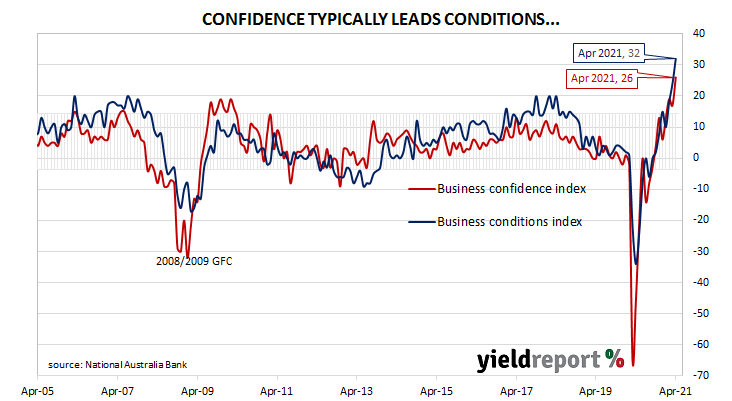Summary: Business conditions improve in April, hits new record high; confidence also hits record high; “many aggregate indicators reaching new highs”; capacity usage rate increases again; all eight sectors of economy at or above respective long-run averages; implies further falls in jobless rate; ‘super-boom’ in economy; economists split on inflation outlook.
NAB’s business survey indicated Australian business conditions were robust in the first half of 2018, with a cyclical-peak reached in April of that year. Readings from NAB’s indices then began to slip, declining to below-average levels by the end of 2018. Forecasts of a slowdown in the domestic economy began to emerge in the first half of 2019 and the indices trended lower, hitting a nadir in April 2020 as pandemic restrictions were introduced. Conditions have improved markedly since then and NAB’s indices are both back at elevated levels.
According to NAB’s latest monthly business survey of over 400 firms conducted over the second half of April, business conditions improved again as the NAB index hit a new record high. NAB’s conditions index registered 32, up from March’s revised reading of 24.
Business confidence also improved; NAB’s confidence index increased from March’s revised reading of 17 to 26, also a record high. Typically, NAB’s confidence index leads the conditions index by approximately one month, although some divergences have appeared in the past from time to time.
“This month’s survey saw another very strong result, with many aggregate indicators reaching new highs,” said NAB chief economist Alan Oster.

Long-term Commonwealth Government bond yields increased on the day, rising more than their US counterparts had overnight. By the end of the day, 10-year and 20-year ACGB yields had each gained 3bps to 1.66% and 2.39% respectively. The 3-year yield remained unchanged at 0.25%.
In the cash futures market, expectations of a change in the actual cash rate, currently at 0.03%, remained fairly stable. At the end of the day, contract prices implied the cash rate would creep up to around 0.11% by October 2022.

